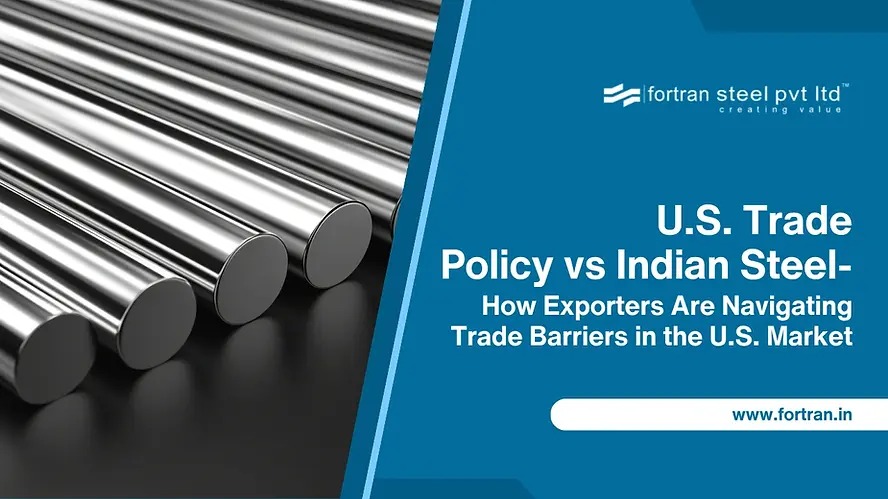How Indian Steel Exporters Are Tackling U.S. Trade Barriers in 2025: Tariffs, Duties & Compliance

Strong 8k brings an ultra-HD IPTV experience to your living room and your pocket.
The United States remains a vital export destination for Indian steel—but tightening trade regulations have reshaped the way Indian exporters operate in the U.S. market.
From rising tariff barriers to stricter compliance frameworks, Indian steel exporters now face a more complex and competitive landscape. Products like bright bars, galvanized steel, and steel wire—long valued by U.S. buyers—are now subject to a maze of policies, including anti dumping duty on steel and safeguard duty on steel.
At the same time, India’s own domestic policy decisions—like the proposed 24% safeguard duty on steel—mirror the global shift toward protectionism. For manufacturers focused on the India steel export to USA corridor, this dual pressure demands smarter trade strategy, adaptive pricing, and transparent compliance.
In this expert breakdown, Fortran Steel, a leading steel manufacturing company in India, explores:
Key changes in the U.S. steel import policy
How Indian exporters are responding to the trade barriers
Which steel products are under the most scrutiny
What U.S. buyers can do to continue sourcing from India confidently
Understanding U.S. Trade Barriers on Steel
The U.S. employs a mix of safeguard duty on steel, anti dumping duty on steel, and strategic tariffs to protect its domestic steel industry. These trade actions—though sometimes global—have specific impacts on Indian steel manufacturers and their ability to compete in the American market.
Section 232: The Foundation of Tariff Pressures
In 2018, the U.S. enacted a 25% tariff under Section 232 of the Trade Expansion Act, citing national security concerns related to steel dependency. Although this wasn’t targeted solely at India, the repercussions for India steel export to USA were immediate.
Fast-forward to 2025, and the situation has intensified: tariffs on some Indian steel products have been doubled to 50%, adding further cost pressure and regulatory complexity. These measures are part of an ongoing effort to support U.S. mills and limit high-volume imports.
Anti Dumping Duty on Steel: High-Risk Product Categories
Whereas safeguard duties aim to curb overall import volumes, anti dumping duties focus on products sold below fair market value. Indian exports such as bright bars, stainless steel wires, and steel nails are often flagged for pricing reviews under these measures.
With new compliance rules coming into effect in 2025, Indian steel exporters to USA must prepare for intensified scrutiny—especially on high-volume or underpriced shipments.
The Section 301 Factor & New Tariff Layers
Although Section 301 tariffs primarily target other countries, they’ve contributed to an overall tightening of U.S. steel import policy. This has created layered pricing structures, higher uncertainty, and operational challenges for Indian exporters.
Today, Indian steel businesses must navigate not just standard steel import duty USA rates, but also shifting rules under Section 232, 301, and anti-dumping frameworks—all of which impact final landed cost, delivery lead time, and profitability.
Why Indian Steel Is Under the U.S. Radar
India has rapidly emerged as a major player in global steel exports. Thanks to strong capabilities in both core materials and value-added steel segments, Indian steel manufacturers are now counted among the top steel producing companies globally. Their growing footprint in the U.S. market, however, has triggered greater regulatory scrutiny.
India’s Growing Share in U.S. Steel Imports
As American buyers diversify sourcing in response to the evolving U.S. steel import policy, Indian steel exporters have steadily captured market share. This growth is fueled by India's strong global reputation for quality, cost-effective production, and consistent delivery.
Today, steel exports from India are viewed as a reliable solution for U.S. sectors that prioritize compliance, value, and supply chain stability. But this success comes at a cost—namely, closer monitoring by the U.S. Trade Representative (USTR). Increasing volumes of India steel export to USA have placed Indian products, especially in competitive categories like bright bars and steel wires, under the USTR’s microscope.
Competitive Strength Meets U.S. Protectionism
India’s natural strengths—low-cost raw material access, advanced steelmaking technologies, and flexible production—have made it an attractive supplier. But these same strengths are now triggering more aggressive U.S. protectionist policies.
As Indian steel increasingly competes with both domestic and Chinese suppliers, the perception that it could displace U.S.-made products is growing. This has led to more calls for higher tariffs on Indian steel, extended U.S. safeguard duty programs, and stricter enforcement of the anti dumping duty on steel.
By 2025, U.S. trade agencies have intensified their focus on product groups like TMT bars, which have experienced rapid growth in U.S.-bound shipments. This environment demands that Indian exporters be nimble, strategic, and fully compliant with U.S. trade laws.
Rising Concerns Over Trade Balance
Alongside these product-specific concerns, there’s also political pressure surrounding the growing trade imbalance between India and the U.S. The increasing volume of India steel export to USA is now part of a larger policy conversation, where economic data intersects with diplomatic agendas.
Domestic U.S. steel lobbies have become more vocal, arguing that Indian exporters benefit from unfair pricing advantages and higher production capacity. These arguments are driving momentum for stricter trade barriers in US, raising the risk of new policy measures aimed directly at Indian shipments.
Key Challenges for Indian Steel Exporters
Even though Indian steel is globally competitive, entering the U.S. market in 2025 is far from simple. Exporters face a mix of financial, regulatory, and operational hurdles that can affect both margins and delivery reliability.
Rising Export Costs from Duties
The steel import duty USA—especially under Section 232—continues to drive up export costs. For standard commodity-grade steel, these tariffs often erode the pricing advantage India offers. As a result, many Indian steel exporters are shifting focus to high-value products like stainless steel wires, coil nails, and customized bright bars, where higher margins can absorb the additional duty burden.
Regulatory Complexity and Documentation
Exporting steel to the U.S. now requires meticulous documentation under the latest trade compliance rules for Indian steel exporters to USA. Proper HS code classification, updated origin certificates, and accurate product specs are critical. A single misstep in paperwork can cause customs delays, rejections, or penalty charges—especially for small to mid-sized exporters.
Delays at Ports and Customs
Due to enhanced scrutiny under the anti dumping duty on steel framework, Indian shipments are now more frequently inspected at U.S. ports. These checks delay delivery, disrupt B2B timelines, and create cash flow strain. Even the most reliable steel manufacturers in India affected by U.S. duties must now plan with increased lead times and more working capital buffers.
Increased Global Competition
The challenge isn’t only from U.S. regulations. With American buyers reducing reliance on imports from certain countries, Indian exporters now face pressure from alternative global suppliers. This adds a new layer of competition, making pricing, compliance, and logistics efficiency more important than ever for Indian steelmakers.
How Indian Companies Are Responding
Despite the tightening environment, many Indian steel exporters are proactively adapting to ensure their continued success in the U.S. market.
Here’s how they’re doing it:
Setting up U.S.-based warehouses: Local warehousing helps speed up delivery, smoothens customs clearance, and enhances client confidence.
Focusing on value-added steel products: By shifting focus to premium-grade items less impacted by anti dumping duty on steel, exporters can maintain profitability and reduce regulatory friction.
Upgrading trade compliance systems: Indian firms are investing in legal support and internal controls to meet the complex trade compliance rules for Indian steel exporters to USA.
Engaging with policy influencers: Trade associations and exporter groups are working with both Indian and U.S. stakeholders to influence future updates to U.S. safeguard duty and tariff structures.
Diversifying U.S. buyer base: Exporters are expanding their reach across multiple industries and buyer segments in the U.S., reducing dependency on any single sector or client.
Forecast: What Lies Ahead for Indian Steel in the U.S. Market
As the global steel trade continues to evolve, Indian steel exporters must prepare for a future shaped by policy shifts, competitive pressures, and diplomatic negotiations. The U.S. remains a valuable but challenging destination—one where strategic foresight will be critical to long-term success.
Expected Trade Policy Changes in the U.S.
U.S. policymakers are actively reviewing both the U.S. safeguard duty on steel and potential revisions to anti dumping duty on steel for specific categories. With the U.S. elections in 2025 looming, political momentum is building around domestic steel protection, raising the stakes for exporters.
The lingering effects of the U.S. trade war on Indian steel remain a key risk factor, particularly as trade talks tighten and enforcement becomes more aggressive. Indian exporters must closely monitor these developments to stay ahead of compliance changes and pricing adjustments.
India’s Trade Negotiation Stance
India is not standing still. The government is actively engaging with U.S. trade representatives to achieve a more equitable framework. These efforts focus on:
Reducing tariff pressure under USTR policy on Indian steel
Revisiting the implications of Section 232 steel import duty USA
Seeking exemptions or bilateral terms that ease the burden on steel manufacturers in India affected by U.S. duties
The goal: protect the competitiveness of Indian exporters while preserving fair access to the U.S. market.
The Future of U.S.-India Steel Relations
The road ahead for India steel export to USA will be shaped by:
Ongoing trade negotiations
Global steel demand cycles
Evolving U.S. steel import policy
Despite the current headwinds, American buyers still value Indian steel for its consistency, cost-effectiveness, and regulatory compliance. Those exporters who invest in trade intelligence, supply chain agility, and relationship management will remain well-positioned to thrive—even as new trade barriers for Indian steel companies in U.S. market emerge.
Conclusion: Staying Competitive Amid Uncertainty
The U.S. market continues to be a high-potential destination for Indian steel exporters, but navigating it in 2025 and beyond will require focus, compliance, and resilience.
Key takeaways:
- Steel import duty USA, especially under Section 232, is impacting pricing power.
- Enforcement of anti dumping duty on steel is tightening.
- More U.S. buyers are demanding policy-compliant, ready-to-ship steel products.
- Exporters must respond with smarter strategies—higher-value offerings, reliable delivery, and proactive policy engagement.
Fortran Steel is proud to lead this transformation. As one of the top-performing steel manufacturers in India affected by U.S. duties, we specialize in high-quality, trade-compliant steel exports that meet evolving American market needs.
🚀 Get in Touch
Partner with Fortran Steel for reliable, compliant, and competitive steel sourcing in the U.S. market. Let’s navigate trade challenges together—with confidence.
👉 Contact Us Today to discuss your steel requirements.
You Might Also Like
Where To Buy High-Quality Steel Nails in the USA for Industrial Use
FAQs
What is the current safeguard duty on Indian steel exports to the USA?
As of 2025, while there is no exclusive safeguard duty on steel targeting India, Section 232 imposes a 50% steel import duty USA on most Indian steel exports.
How are Indian steel companies responding to U.S. tariffs?
Indian companies are diversifying into value-added segments, investing in U.S.-based warehousing, and advocating for fair trade through India's diplomatic efforts under the USTR policy on Indian steel.
Which Indian steel products are in demand in the U.S. market?
Popular exports include high-grade bright bars, structural steel, PPGI coils, and precision wire products, all tailored to comply with U.S. steel import policy standards.
Is anti-dumping duty different from safeguard duty?
Yes. Anti dumping duty on steel targets unfair pricing, while safeguard duty on steel addresses import surges that threaten domestic producers—regardless of pricing.
Can Indian exporters still profit while dealing with U.S. trade barriers?
Absolutely. By focusing on niche products, enhancing compliance readiness, and building strong relationships, Indian steel exporters can stay competitive and continue growing their footprint in the U.S.
Note: IndiBlogHub features both user-submitted and editorial content. We do not verify third-party contributions. Read our Disclaimer and Privacy Policyfor details.


